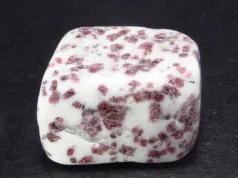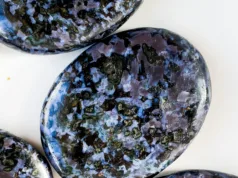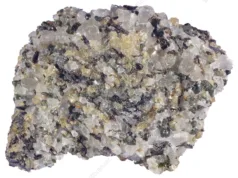Norite is a type of igneous rock that is primarily composed of the mineral orthopyroxene, along with plagioclase feldspar. It is a mafic rock, meaning it has a high content of dark-colored minerals, such as pyroxene and/or amphibole. The term “norite” is derived from the Norwegian word “nord,” meaning north, as it was first described in Norway.

Here’s a breakdown of the key components:
- Orthopyroxene: This mineral is a type of pyroxene that crystallizes in the orthorhombic system. Common orthopyroxenes found in norite include hypersthene and bronzite.
- Plagioclase Feldspar: Norite typically contains plagioclase feldspar, which is a group of aluminum silicate minerals. The specific type of plagioclase can vary, but it often falls within the range of labradorite to bytownite.
- Mafic Minerals: In addition to orthopyroxene and plagioclase, norite may contain other mafic minerals like olivine and amphibole, depending on the specific geological conditions of its formation.
Norite is part of a larger family of rocks known as plutonic rocks or intrusive rocks. These rocks form from the slow cooling and solidification of molten magma beneath the Earth’s surface. The slow cooling allows larger crystals to form, giving plutonic rocks a coarse-grained texture.
As an igneous rock, norite is classified based on its mineral composition and texture. The classification of norite falls within the broader category of gabbroic rocks. Gabbroic rocks, including norite, are characterized by their high content of dark minerals and are often associated with the deeper parts of the Earth’s crust.
In summary, norite is an igneous rock with a distinctive composition dominated by orthopyroxene and plagioclase feldspar. It is part of the plutonic rock family and is classified as a mafic rock within the gabbroic group.
Formation of Norite
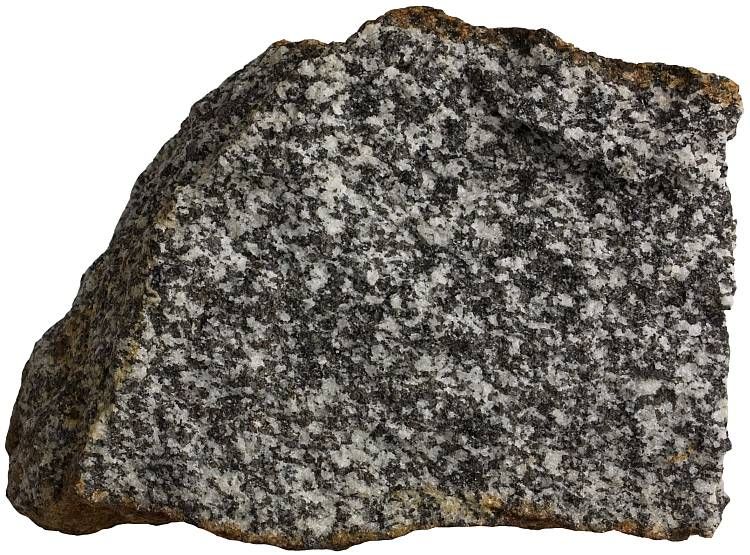
The formation of norite is closely tied to the cooling and solidification of magma beneath the Earth’s surface. Here’s a step-by-step overview of its formation:
- Magma Generation: Norite originates from the partial melting of the Earth’s mantle. Magma, which is molten rock, is formed as a result of this process. The composition of the magma is critical to the eventual mineralogy of the rock.
- Intrusion into the Earth’s Crust: Once formed, the magma rises towards the Earth’s crust through fractures and conduits. It eventually intrudes into the crust, often at depths ranging from several kilometers to tens of kilometers beneath the Earth’s surface.
- Slow Cooling: Norite is classified as a plutonic or intrusive rock because it forms from magma that cools and solidifies beneath the Earth’s surface over an extended period. The cooling process is slow, allowing for the growth of relatively large crystals.
- Mineral Crystallization: As the magma cools, minerals within it begin to crystallize. Orthopyroxene, the characteristic mineral in norite, starts forming crystals, along with plagioclase feldspar and potentially other mafic minerals like olivine or amphibole, depending on the specific conditions.
- Grain Size Development: The slow cooling process contributes to the coarse-grained texture of norite. Large crystals have more time to grow before the rock solidifies completely. The resulting texture is visible to the naked eye and distinguishes plutonic rocks from their fine-grained counterparts, volcanic or extrusive rocks.
- Emplacement: Norite bodies can be found in various geological settings, often as intrusive bodies or plutons within the Earth’s crust. These bodies can range in size from relatively small to large, forming significant portions of the Earth’s crust.
The overall process of norite formation is part of the broader geological cycle that involves the movement and transformation of Earth’s materials. The slow cooling and crystallization beneath the surface contribute to the unique mineral composition and coarse-grained texture characteristic of norite and other plutonic rocks.
Mineral Composition of Norite
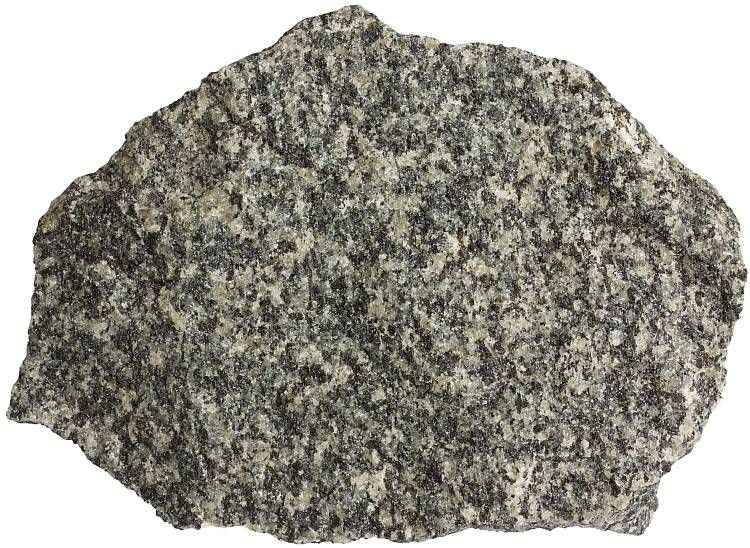
The mineral composition of norite is characterized by the presence of specific minerals, with orthopyroxene and plagioclase feldspar being the key constituents. Additionally, norite may contain other minerals depending on the specific conditions of its formation. Here’s a breakdown of the typical mineral composition:
- Orthopyroxene: Norite is primarily composed of orthopyroxene minerals, with common examples being hypersthene and bronzite. Orthopyroxenes crystallize in the orthorhombic system and are dark-colored minerals, contributing to the overall mafic (rich in iron and magnesium) nature of the rock.
- Plagioclase Feldspar: Another major mineral in norite is plagioclase feldspar. The specific type of plagioclase can vary, but it typically falls within the range of labradorite to bytownite. Plagioclase feldspar is a group of minerals within the feldspar family, and its presence gives norite a lighter color compared to the dark orthopyroxene.
- Other Mafic Minerals: In addition to orthopyroxene and plagioclase feldspar, norite may contain other mafic minerals such as olivine and amphibole. The presence of these minerals depends on factors like the composition of the original magma and the specific geological conditions during norite formation.
- Accessory Minerals: Norite may also include accessory minerals, which are present in smaller amounts. These can include minerals like magnetite, ilmenite, and apatite, among others.
The exact mineral composition of norite can vary from one occurrence to another, depending on factors like the geological setting, the composition of the original magma, and the cooling history of the rock. The combination of orthopyroxene and plagioclase feldspar, however, remains a consistent feature in norite, distinguishing it as a specific type of plutonic rock within the larger category of gabbroic rocks.
Texture
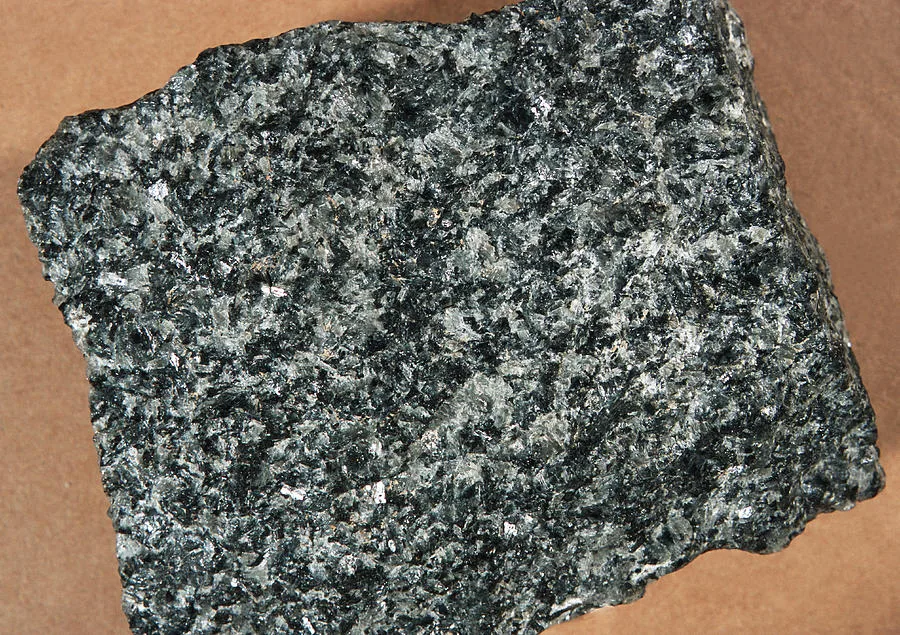
The texture of norite is characterized by its coarse-grained appearance, which is a result of the slow cooling and solidification of magma beneath the Earth’s surface. The key features of the texture include:
- Coarse Grains: Norite exhibits relatively large mineral crystals that are easily visible to the naked eye. The slow cooling process allows these crystals to grow over an extended period, contributing to the coarse-grained texture. In contrast to fine-grained rocks formed from rapid cooling at or near the Earth’s surface (such as volcanic rocks), the coarse-grained texture of norite indicates its plutonic or intrusive origin.
- Interlocking Crystals: The mineral crystals in norite typically interlock with one another, forming an interconnected matrix. This interlocking texture is a common characteristic of many plutonic rocks and is a result of the minerals growing in a slow-cooling environment.
- Mineral Abundance: The dominant minerals in norite, orthopyroxene, and plagioclase feldspar, are often present in significant quantities, contributing to the overall composition and appearance of the rock. Other mafic minerals, such as olivine or amphibole, may also be present, depending on the specific conditions of formation.
- Porphyritic Texture (Optional): In some cases, norite may exhibit a porphyritic texture, where larger crystals (phenocrysts) are embedded in a finer-grained matrix. This can occur if there were variations in the cooling rate or if the rock underwent partial melting and recrystallization.
The coarse-grained texture of norite is a result of the deep-seated, intrusive nature of its formation. It contrasts with the finer-grained textures of volcanic or extrusive rocks, which cool rapidly on or near the Earth’s surface. The specific appearance of norite can vary based on the mineral composition, the rate of cooling, and other geological factors influencing its formation.
Occurrence Geographical Distribution Tectonic Settings of Norite
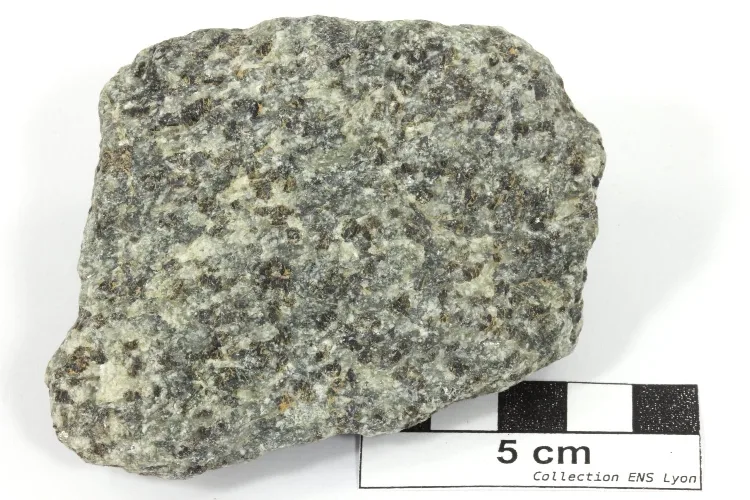
Occurrence: Norite is a type of plutonic rock and is commonly found in large intrusive bodies or plutons. These bodies are often associated with the deep-seated parts of the Earth’s crust. Norite can occur as individual intrusive masses or as part of larger layered intrusions. Layered intrusions, also known as mafic-ultramafic intrusions, consist of layers of different igneous rocks, and norite is often one of these layers. These intrusions are significant geological features, and examples can be found on various continents.
Geographical Distribution: Norite is found in various regions around the world, and its distribution is often associated with specific geological settings. Some notable occurrences include:
- Norway: The rock was first described in Norway, and occurrences can be found in various parts of the country.
- South Africa: Norite is associated with layered intrusions in the Bushveld Igneous Complex in South Africa, where it is often found along with other igneous rocks such as anorthosite and gabbro.
- Greenland: Norite is also reported in parts of Greenland, where layered intrusions are present.
- North America: Occurrences of norite can be found in various locations in North America, including Canada and the United States.
- Other Locations: Norite is not limited to these regions and can be found in other parts of the world where suitable geological conditions exist for its formation.
Tectonic Settings: The formation of norite is closely tied to specific tectonic settings where magma is generated and intrudes into the Earth’s crust. Norite is commonly associated with the following tectonic settings:
- Convergent Boundaries: Norite can form in areas where tectonic plates converge, leading to subduction zones. The subduction of oceanic plates into the mantle can result in the partial melting of the mantle, giving rise to the magma that eventually intrudes into the crust and forms norite.
- Intraplate Settings: Intraplate settings, away from active plate boundaries, can also host norite formations. In these cases, upwelling mantle plumes can generate magma, leading to the formation of large layered intrusions that include norite.
Understanding the geological and tectonic context is crucial for interpreting the occurrence and distribution of norite in different regions around the world.
Geological Significance
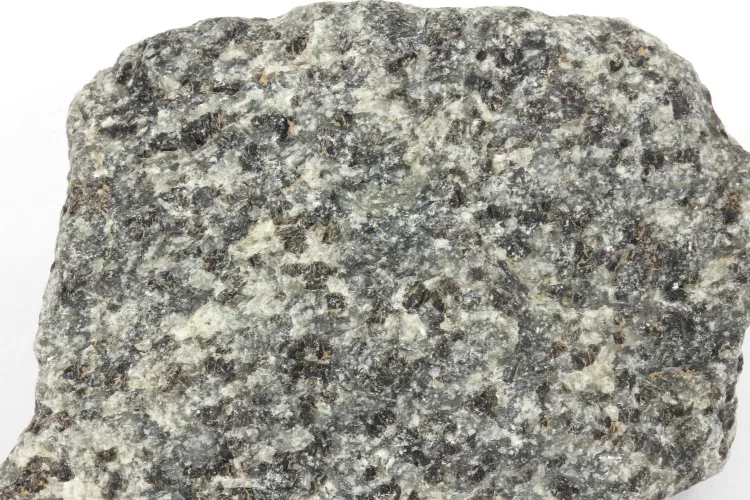
Norite, like other igneous rocks, holds geological significance for several reasons:
- Indicator of Tectonic Processes: The occurrence of norite is often associated with specific tectonic processes, such as convergent boundaries or intraplate settings. By studying the distribution and characteristics of norite formations, geologists can gain insights into the tectonic history and processes that have shaped a particular region.
- Formation of Layered Intrusions: Norite is commonly found in layered intrusions, which are large bodies of igneous rock with distinct layers. The study of layered intrusions, including the norite layers, provides valuable information about the processes of magma emplacement, crystallization, and differentiation in the Earth’s crust.
- Understanding Mantle Dynamics: Norite’s formation involves the partial melting of the Earth’s mantle, and its occurrence can provide clues about the composition and dynamics of the mantle. This is particularly relevant in regions where norite is associated with mantle plumes or other mantle processes.
- Mineral Resource Potential: Some layered intrusions, including those containing norite, may host valuable mineral resources. For example, these intrusions can be associated with deposits of platinum-group elements (PGEs), chromium, and other economically important minerals. Understanding the geological setting of norite formations can be crucial for mineral exploration.
- Dating Geological Events: Radiometric dating of minerals within norite can be used to determine the age of the rock and associated geological events. This helps geologists establish timelines for the formation and cooling of magma, as well as the broader geological history of a region.
- Crustal Evolution: The study of norite contributes to our understanding of the evolution of the Earth’s crust. By examining the mineralogy and texture of norite, geologists can infer processes related to crustal growth, differentiation, and magmatic evolution.
- Petrological Research: Norite serves as a subject of petrological research, helping scientists understand the conditions under which specific minerals crystallize, the relationships between different minerals, and the factors influencing the overall texture of the rock. This research contributes to our broader understanding of igneous petrology.
In summary, norite is significant in the field of geology for its role in providing insights into tectonic processes, mantle dynamics, mineral resources, and the evolution of the Earth’s crust. It serves as a valuable tool for unraveling the geological history of regions where it is found.
Uses of Norite
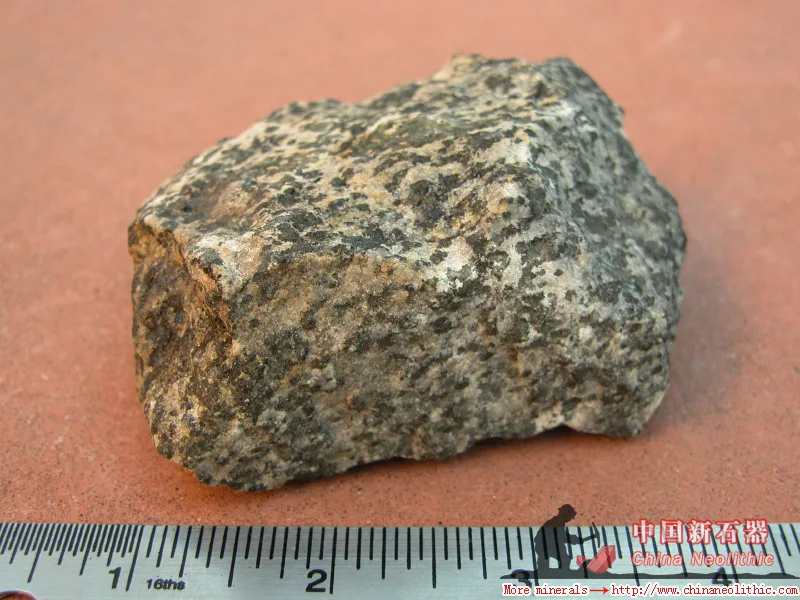
Norite, as an igneous rock, has various uses based on its physical and chemical properties. Here are some of the potential applications:
- Construction Material: Norite’s durability and strength make it suitable for use as a construction material. It can be quarried and used as crushed stone for road construction, concrete aggregates, and railroad ballast. The hardness and resistance to abrasion of norite contribute to its effectiveness in these applications.
- Dimension Stone: Some varieties of norite with attractive textures and colors can be used as dimension stone. Dimension stone is often employed for decorative purposes in buildings, monuments, and landscaping projects. The coarse-grained texture and distinctive mineral composition can enhance the visual appeal of architectural elements.
- Monumental Stone: Norite may be used in the creation of monuments and memorials due to its durability and ability to take a polished finish. Its use in this context is similar to other granitic rocks.
- Decorative Aggregates: Crushed norite can be used as decorative aggregates in landscaping and hardscaping projects. Its dark color and coarse texture can provide a visually appealing contrast in gardens, pathways, and other outdoor spaces.
- As a Source of Minerals: Some norite formations may contain economically valuable minerals such as platinum-group elements (PGEs), chromium, and nickel. Mining operations may target these minerals as valuable resources.
- Geological and Petrological Research: Norite is an important subject of geological and petrological research. Studying norite formations provides insights into magmatic processes, the Earth’s mantle, and the evolution of the Earth’s crust.
While norite may not be as widely used as some other types of rocks, its unique characteristics and properties make it valuable in specific applications, particularly in the construction and decorative industries. The uses of norite depend on its location, mineral composition, and the economic considerations of the region where it is found.
Comparison with Related Rocks
Norite belongs to the broader category of gabbroic rocks and is closely related to several other types of igneous rocks. Here’s a comparison with some of the related rocks:
- Norite vs. Gabbro:
- Norite: Primarily composed of orthopyroxene and plagioclase feldspar. May contain other mafic minerals like olivine and amphibole. Coarse-grained texture due to slow cooling and solidification beneath the Earth’s surface.
- Gabbro: Similar to norite but with a greater emphasis on the presence of olivine and/or amphibole. Coarse-grained texture, formed from slow cooling of magma, often in the lower crust or upper mantle.
- Norite vs. Anorthosite:
- Norite: Contains orthopyroxene and plagioclase feldspar. Dark-colored due to the abundance of mafic minerals. Coarse-grained texture.
- Anorthosite: Composed predominantly of plagioclase feldspar, typically with little to no dark-colored minerals. Light-colored and coarse-grained. Often associated with the upper layers of layered intrusions.
- Norite vs. Diorite:
- Norite: Mafic rock with orthopyroxene and plagioclase feldspar. Coarse-grained texture.
- Diorite: Intermediate in composition between felsic and mafic rocks. Contains plagioclase feldspar, amphibole, and/or biotite. Coarse-grained texture. Commonly found in subduction zone settings.
- Norite vs. Peridotite:
- Norite: Contains orthopyroxene, plagioclase feldspar, and potentially other mafic minerals. Typically found in the middle to lower crust.
- Peridotite: Ultramafic rock composed mostly of olivine and pyroxene. Usually associated with the mantle and often brought to the surface through tectonic processes.
- Norite vs. Troctolite:
- Norite: Contains orthopyroxene and plagioclase feldspar. Coarse-grained texture.
- Troctolite: Similar to norite but with a higher proportion of plagioclase feldspar compared to orthopyroxene. Also coarse-grained. Both are often associated with layered intrusions.
These comparisons highlight the distinctions and similarities between norite and related rocks, considering factors such as mineral composition, texture, and geological settings. The variations in these rocks are important for understanding the diverse processes that occur in the Earth’s crust and mantle.
Conclusion
Norite is an igneous rock with a distinctive composition primarily made up of orthopyroxene and plagioclase feldspar. It exhibits a coarse-grained texture, indicative of its slow cooling and solidification beneath the Earth’s surface. Here’s a summary of key points and its significance in geology and industry:
Key Points:
- Composition: Norite is primarily composed of orthopyroxene and plagioclase feldspar. It may also contain other mafic minerals like olivine and amphibole.
- Texture: The rock has a coarse-grained texture, resulting from slow cooling and solidification in the subsurface. The large crystals are visible to the naked eye.
- Formation: Norite forms through the intrusion of magma into the Earth’s crust, followed by slow cooling and crystallization. It is often associated with layered intrusions and certain tectonic settings.
- Geographical Distribution: Norite is found in various regions globally, with notable occurrences in Norway, South Africa, Greenland, and North America.
- Tectonic Settings: Its formation is linked to specific tectonic settings, such as convergent boundaries and intraplate regions. Norite provides insights into the Earth’s crust and mantle dynamics.
- Uses: Norite has practical applications, including:
- Construction material for road building, concrete aggregates, and railroad ballast.
- Dimension stone and monumental stone for architectural and landscaping purposes.
- Decorative aggregates in landscaping projects.
- Potential as a source of economically valuable minerals like platinum-group elements.
Significance in Geology and Industry:
- Tectonic Insights: Norite occurrences contribute to our understanding of tectonic processes, including plate convergence, subduction, and intraplate magmatism.
- Mantle Dynamics: The formation of norite involves partial melting of the mantle, offering insights into mantle composition and dynamics.
- Mineral Resources: Some norite formations host valuable minerals, making them important targets for mineral exploration and mining activities.
- Crustal Evolution: Studying norite helps in unraveling the geological history of regions, contributing to our understanding of crustal evolution.
- Petrological Research: Norite serves as a subject for petrological research, aiding scientists in understanding magmatic processes and rock formation.
In summary, norite’s geological significance lies in its role as a marker of tectonic processes, its contribution to our understanding of mantle dynamics, and its potential as a source of valuable minerals. Its practical applications in construction and landscaping further highlight its significance in various industries.


























